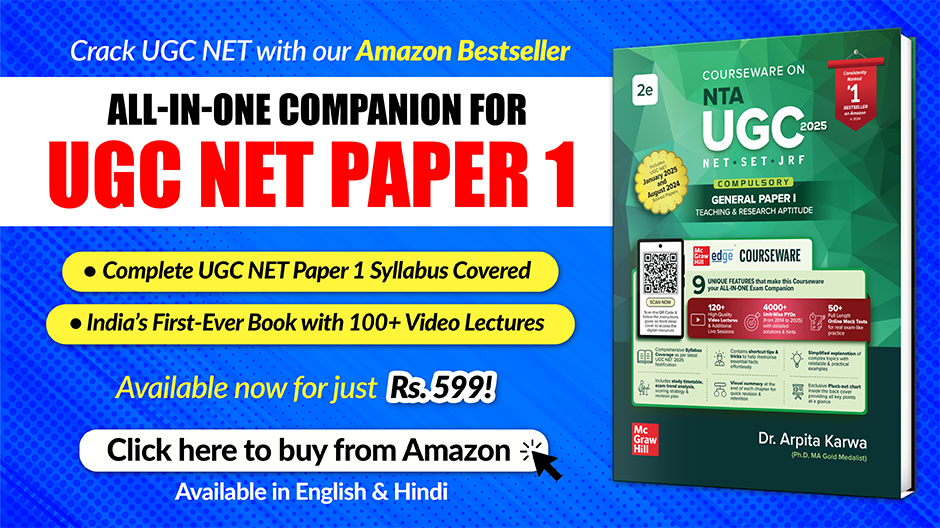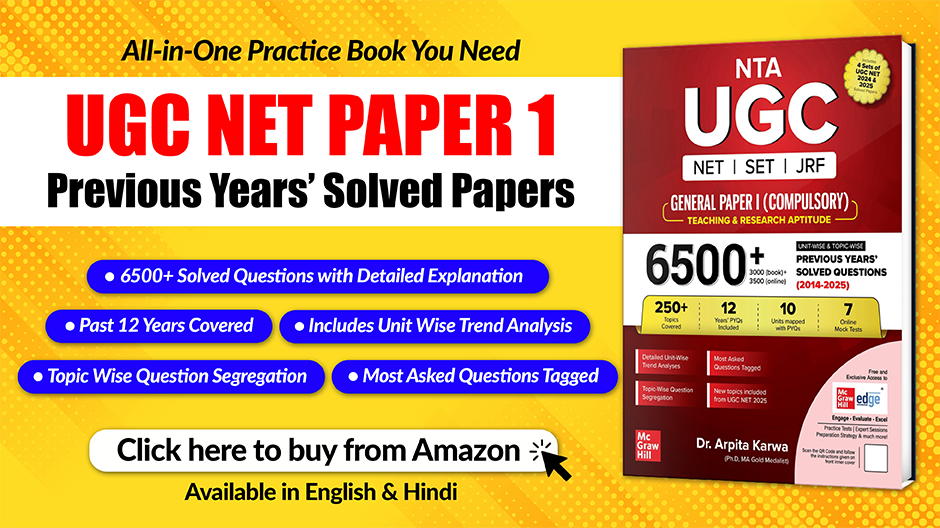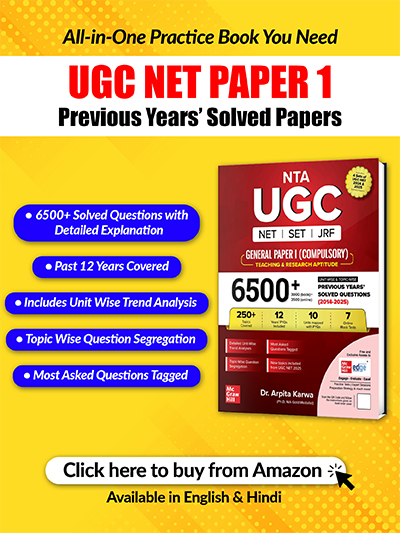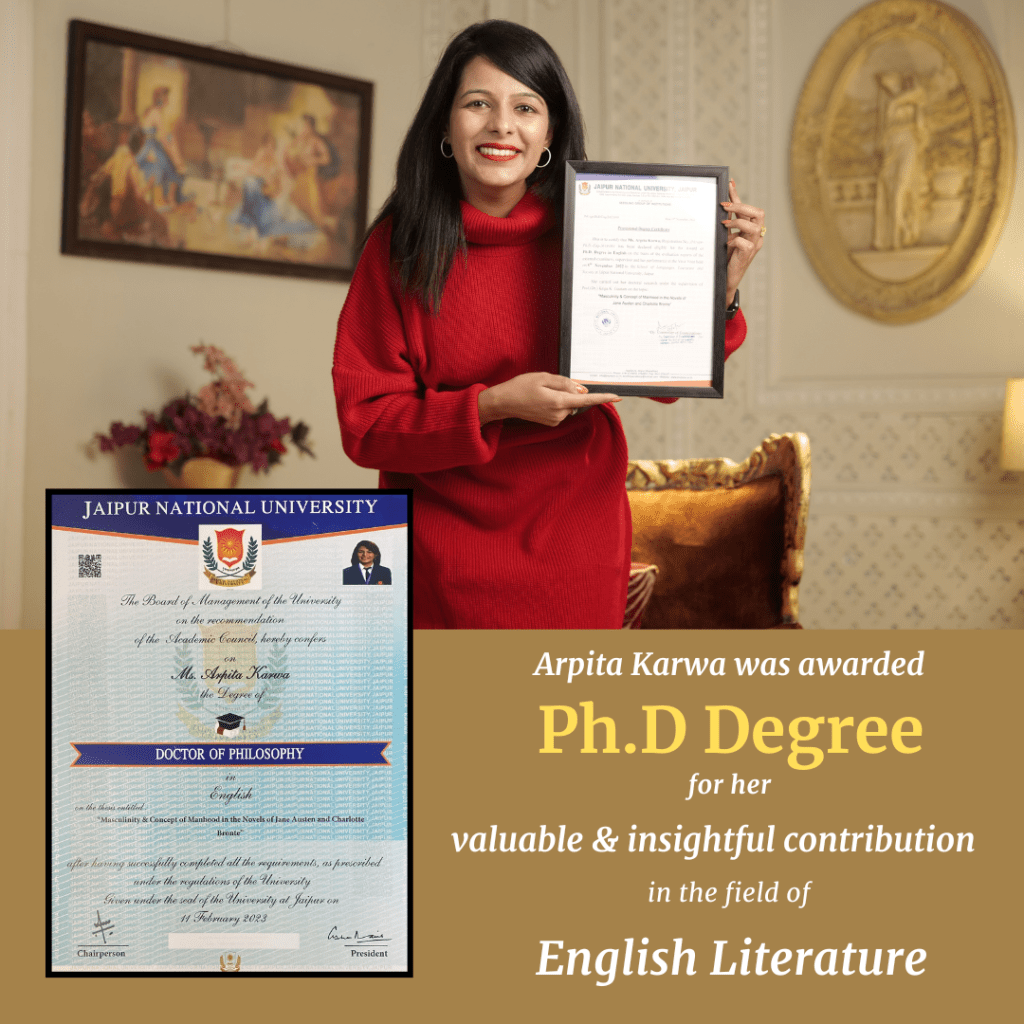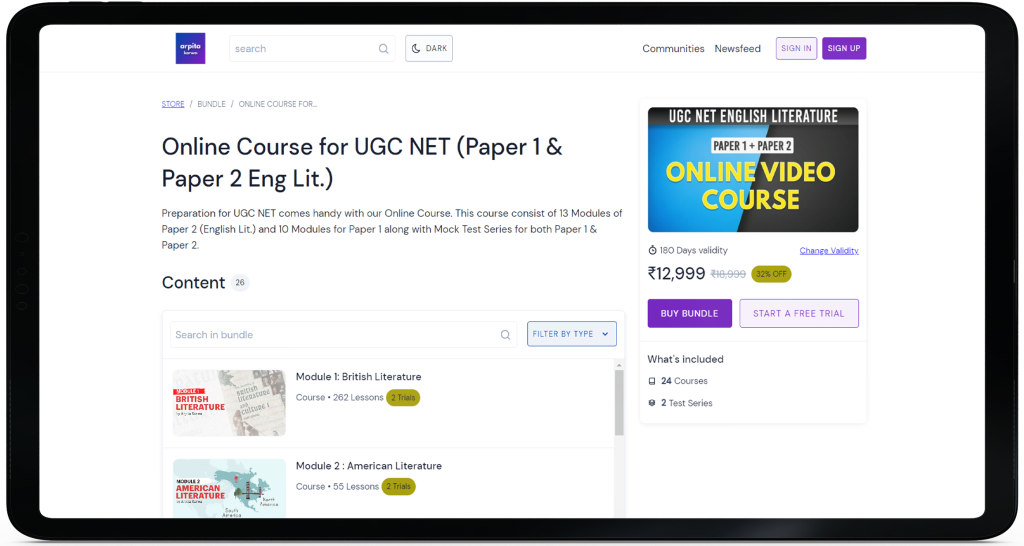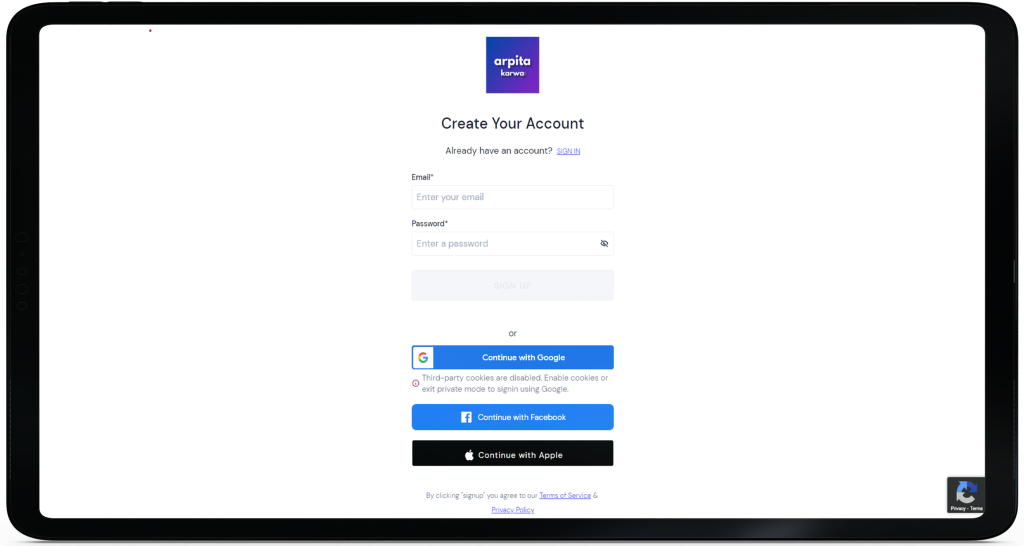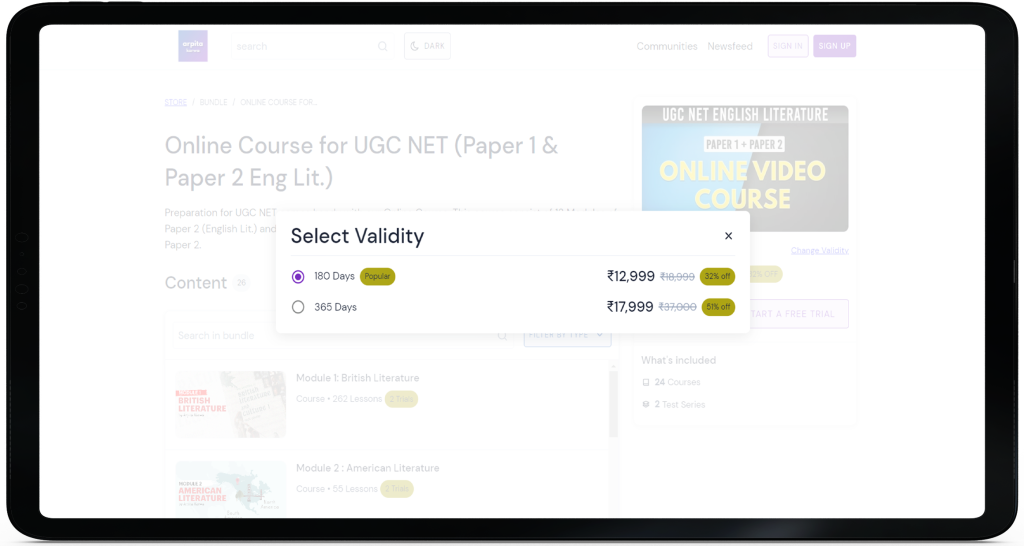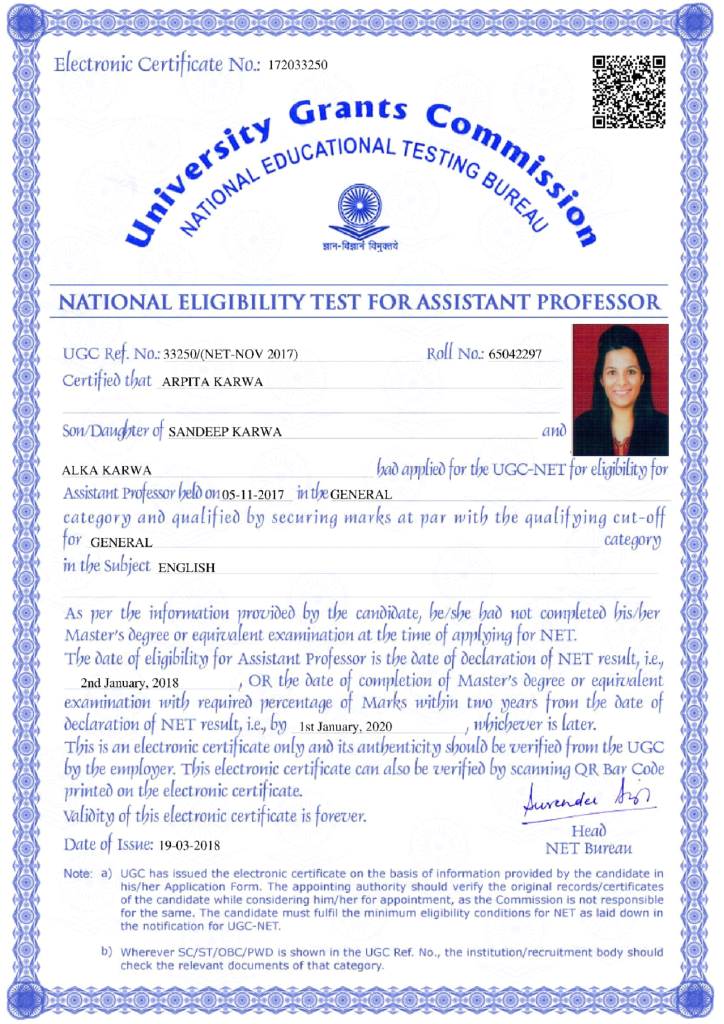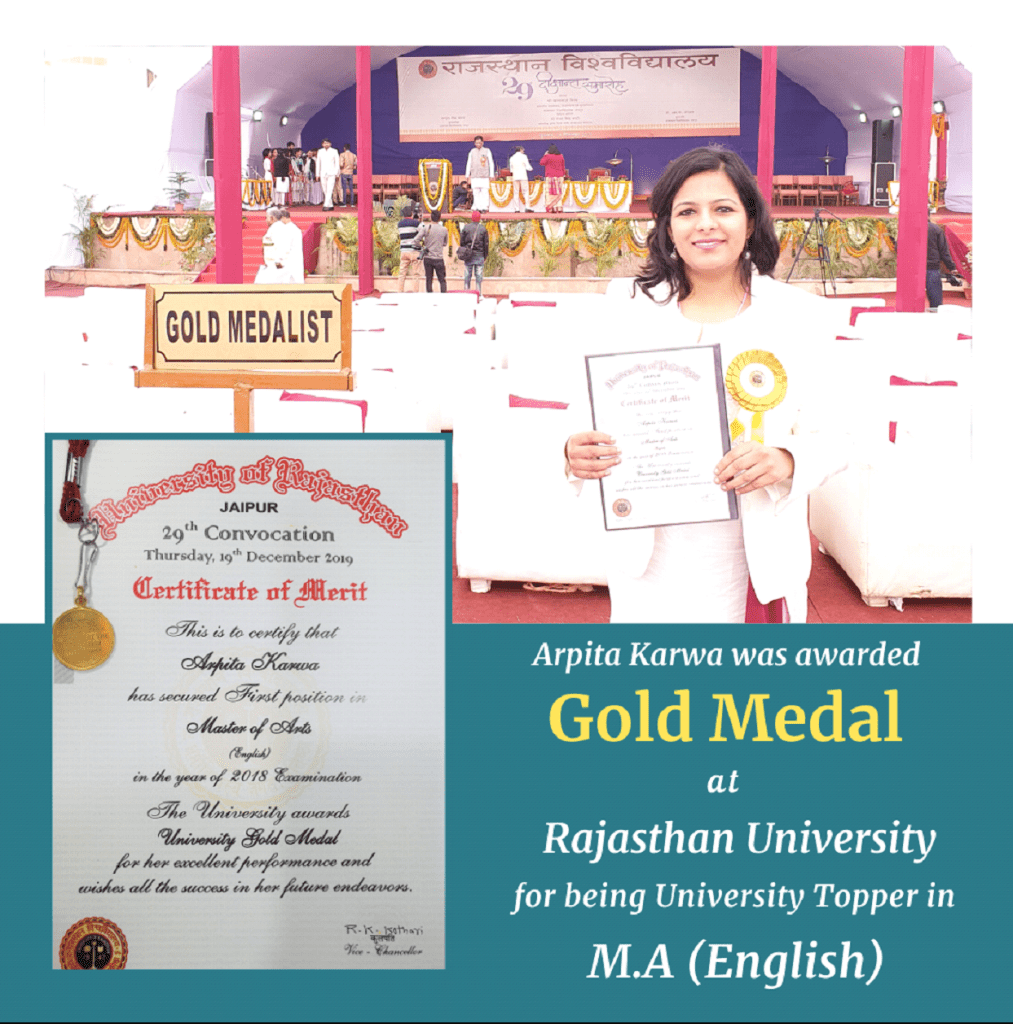UGC NET Paper 1 November 2020 (Conducted on 13th November 2020 : Morning Shift)
October 18, 2022 2025-08-18 14:20UGC NET Paper 1 November 2020 (Conducted on 13th November 2020 : Morning Shift)
November 2020: Paper 1 (Conducted on 13th Nov 2020 : Morning Shift)
Q.1) Identify the characteristics and basic requirements of reflective level teaching in the following list of statements:
a) Teacher presents the information and ideas systematically to help recall them when needed
b) Teacher conducts drills and exercises to fix up the ideas in the minds of students.
c) Issues are raised and discussed with a view to sift the potential rational solution of problems.
d) Teacher asks students to give examples and parallel ideas.
e) Academic sessions are conducted in a dialogic mode to explore and explain the basis of arguments.
[1] ab
[2] cd
[3] ce
[4] de
Correct Answer: 3
Q.2) For effective teaching which of the following is key behavior?
[1] Encouraging students to elaborate their own answer or that of other students.
[2] Summarizing what was told by a student.
[3] Teacher gives comments for the purpose of organizing what is to come.
[4] Making ideas clear to learners who may be at different level of understanding.
Correct Answer: 4
Q.3) Which of the following strategies of teaching are learner-centered?
(a) Cybernetics
(b) Lecture with audio visual aids
(c) Question-answer session
(d) Practical tasks based project
(e) Group discussion
[1] ad
[2] ab
[3] cd
[4] de
Correct Answer: 1
Q.4) Which of the following sequences correctly reflects the development of teaching support systems in Indian higher education?
[1] Audio-visual, Aural-oral, Visual and ICT based.
[2] Aural-oral, Visual, Audio-visual and ICT based
[3] IT based, Audio-visual, Aural-oral and Visual
[4] Visual, Aural-oral, ICT based and Audio-visual
Correct Answer: 2
Q.5) In which of the following evaluation systems, evaluation occurs informally during instructions?
[1] Evaluation in choice-based credit system
[2] Evaluation through computer based testing
[3] Summative evaluation
[4] Formative evaluation
Correct Answer: 4
Q.6)
(a) Fundamental Research
(b) Applied Research
(c) Action Research
(d) Case Study Research
(i) In-depth study with focus on typicalities
(ii) Intervention based ameliorative moves
(iii) Exploring applicability of truths/principles to new situations
(iv) Impact studies to watch effects
(v) Adding to corpus of knowledge by formulating theory
[1] a-v b-iii c-ii d-i
[2] a-i b-ii c-iii d-v
[3] a-iii b-iv c-i d-v
[4] a-ii b-iv c-v d-i
Correct Answer: 1
Q.7) In which of the following research methods, manipulation and control of variables, and randomization of sample are two of the basic requirements?
[1] Ex-post facto research
[2] Descriptive research
[3] Case study research
[4] Experimental research
Correct Answer: 4
Q.8) Which of the following sequences correctly represents the steps of research using a quantitative paradigm?
[1] Hypothesis framing, Hypothesis testing, Conclusions and Reporting.
[2] Establishing a research problem, Hypothesis framing, Hypothesis testing, Generalization and conclusions and Implications of results
[3] Problem identification, Sample selection, Developing a research design and Field work.
[4] Defining a problem, Survey of related studies, Sampling, Data collection and Data analysis
Correct Answer: 2
Q.9) In terms of research ethics. which of the following may be considered as the most vulnerable stage?
[1] Defining the purpose and scope of study
[2] Defining the population and sampling method
[3] Data analysis, interpretation and reporting of results
[4] Selection of research tools whether qualitative or quantitative
Correct Answer: 3
Q.10) ICT application in research is most useful for which of the following reasons?
[1] For reducing the cost of research
[2] For academic establishment
[3] For enhancing scope of accessibility of research data
[4] For promoting dialogic interactions
Correct Answer: 3
Q.11) The key to effective listening by students in a classroom is-
[1] Sympathy towards the teacher
[2] Interest in informal education
[3] Empathetic learning
[4] Desire to memorize
Correct Answer: 3
Q.12) Communicated message is considered as a/an-
[1] Social product
[2] Unnatural product
[3] Spin-off product
[4] Techno product
Correct Answer: 1
Q.13) Semantic noise in classroom communication can be limited by avoiding the use of
[1] Dialogues
[2] Cliched jargon
[3] Non verbal cues
[4] Multi-media
Correct Answer: 2
Q.14) Which of the following are useful in overcoming the communication barriers in a classroom?
a) Identifying the level of redundancy
b) Use of unfamiliar words
c) Ignoring the students’ vocabulary
d) Fragmented sentences
e) Voice inflexion
f) Contextualizing the speech
[1] abc
[2] bcd
[3] cdf
[4] aef
Correct Answer: 4
Q.15) Assertion (A): Skills of oration coupled with wit and humour make classroom communication compelling
Reason(R): Rhetorical interventions do not make classroom communication purposeful
[1] Both (A) and (R ) are true and (R) is the correct explanation of (A)
[2] Both (A) and (R) are true but (R) is NOT the correct explanation of (A)
[3] (A) is true but (R) is false
[4] (A) is false but (R) is true
Correct Answer: 3
Q.16) The missing two numbers in the following series are
1,4,3,16, 5,36, ?,?, 100,
[1] 7, 50
[2] 7, 64
[3] 8, 72
[4] 8, 81
Correct Answer: 2
Q.17) Average of three numbers is 22. Sum of two of the numbers is 24 and these two numbers
are in the ratio 7:5. Find the three numbers.
[1] -6, 30, 42
[2] 6, 25, 35
[3] 14,10, 42
[4] 4, 20, 42
Correct Answer: 3
Q.18) In a certain coding language CHEMISTRY is written as DGFLJRUQZ, then in the same code GEOMETRY will be written as:
[1] HDPLFSSZ
[2] HDLPFSXS
[3] HLDPFSSX
[4] HDPLFSSX
Correct Answer: 4
Q.19) If 20% of (a+b) = 50% of (ab) and 40% of (a-b) = 70% of ab, then what fraction of a is b?
[1] 3/17
[2] -3/17
[3] 4/17
[4] 17/3
Correct Answer: 1
Q.20) The next term in the following series is : ABB, BCF, CDL, ?,
[1] DEU
[2] DET
[3] DES
[4] DER
Correct Answer: 2
Q.21) Out of the given four options which one does not belong to the class of other three? Neurologist, Cardiologist, Alchemist, Gynecologist
[1] Gynecologist
[2] Cardiologist
[3] Alchemist
[4] Neurologist
Correct Answer: 3
Q.22) The proportions “All Indians eat rice” and “Some Indians eat rice” are an example of-
[1] Subalternation
[2] Contraries
[3] Contradictions
[4] Sub contraries
Correct Answer: 1
Q.23) In Indian logic, which means of knowledge is drawn from the similarity between two objects?
[1] Comparison
[2] Inference
[3] Perception
[4] Implication
Correct Answer: 1
Q.24) Which of the following statements expresses information use of language?
[1] Get out of my class.
[2] Why are you so late?
[3] I request my students to be punctual
[4] She is very caring and cooperative
Correct Answer: 4
Q.25) “Mr. X is penniless. Therefore, he should be preferred for admission to college”. This reasoning represents which kind of fallacy?
[1] Ad hominem
[2] Ad misericordiam
[3] Ad baculum
[4] Ignoratio elenchi
Correct Answer: 2
Q.26-30)
Q.26) What is the difference between the number of academic books published by publishing houses A and D?
[1] 450
[2] 504
[3] 540
[4] 604
Correct Answer: 3
Q.27) How many books were given to each distributor by publisher E, if each distributor gets equal number of books?
[1] 1024
[2] 1014
[3] 986
[4] 962
Correct Answer: 2
Q.28) What is the average number of non-academic books published by publishers F and G?
[1] 18850
[2] 18950
[3] 19850
[4] 19950
Correct Answer: 4
Q.29) If the total number of books published by publishers D, E and F is increased by 20% and the total number of books published by the remaining publishers be decreased by 20%, what will be the new average of books published by all the publishers?
[1] 31880
[2] 32518
[3] 33318
[4] 33610
Correct Answer: 1
Q.30) What is the total number of books distributed by publishers C and E?
[1] 53688
[2] 54026
[3] 27513
[4] 27324
Correct Answer: 1
Q.31) Identify the correct pair from the following:
[1] AVI- File Transfer Protocol
[2] Excel – Word Processing Software
[3] HDD – Cloud Storage Facility
[4] Ubuntu – Operating System
Correct Answer: 4
Q.32) BCD stands for-
[1] Binary Coded Decimal
[2] Binary Coded Digit
[3] Bit Coded Decimal
[4] Bit Coded Digit
Correct Answer: 1
Q.33) Which one of the following allows a phone call to be routed over network wires?
[1] Video Conferencing
[2] Teleconferencing
[3] Optical Fibre
[4] VoIP
Correct Answer: 4
Q.34) Which one of the following represents one billion characters?
[1] 1 Kilobyte
[2] 1 Megabyte
[3] 1 Gigabyte
[4] 1 Terabyte
Correct Answer: 3
Q.35) Scrambling of data before transmission across a network to avoid manipulation by a third party is known as:
[1] Protection
[2] Permutation
[3] Detection
[4] Encryption
Correct Answer: 4
Q.36) A measure such as building a plinth wall for floods would be termed as-
[1] Preparedness
[2] Prevention
[3] Mitigation
[4] Adaptation
Correct Answer: 2
Q.37) At present, in India, the total installed renewable power capacity is accounted for by:
(a) Solar Power
(b) Wind Power
(c) Hydropower
(d) Urban and industrial waste to energy conversion
(e) Biomass power
(f) Geothermal power
[1] abcef
[2] abcdf
[3] abcde
[4] abcdef
Correct Answer: 3
Q.38) The most relevant effect of particulate matter in air on human health is:
[1] Impaired blood formation
[2] Chest tightness
[3] Aggravation of respiratory disease
[4] Headache and rise in blood pressure level
Correct Answer: 3
Q.39) Assertion(A) : It is crucial to sustain Himalayan ecosystem
Reason (R): Himalayan ecosystem is home to a number of indigenous tribes.
[1] Both (A) and (R) are true and (R) is the correct explanation of (A).
[2] Both(A) and (R) are true but (R) is NOT the correct explanation of (A).
[3] (A) is true but (R) is false
[4] (A) is false but (R) is true
Correct Answer: 2
Q.40) In developing countries, the fraction of food waste in the composition of municipal solid waste is typically in the range
[1] 10-15%
[2] 20-30%
[3] 25-35%
[4] Greater than 40%
Correct Answer: 4
Q.41) In order to be eligible for the status of ‘Deemed to be University’, an institution, among other essential conditions, must have to its credit, which of the following?
[1] At least 2 research publications in peer reviewed or SCOPUS/WOS
journals per year per faculty
[2] At least 5 research publications in peer reviewed or SCOPUS/WOS
journals per year per faculty.
[3] At least 1 research publication in peer reviewed or SCOPUS/WOS
journals per year per faculty.
[4] At least 3 research publications in peer reviewed journals per year per
faculty
Correct Answer: 1
Q.42) Which of the following schemes of Government of India is to support innovative research projects that are socially relevant, locally need based, nationally important and globally significant?
[1] SPARC
[2] STRIDE
[3] IMPRESS
[4] STARS
Correct Answer: 2
Q.43) Under GATS, higher education policies are to be framed by which of the following Departments?
[1] Education
[2] External Affairs
[3] Commerce and Trade
[4] Urban Planning
Correct Answer: 3
Q.44) Which of the following are the main recommendations of ‘Knowledge Commission’ with regard to higher education in India?
(a) More regulatory institutions
(b) Closure of private universities
(c) Massive expansion of higher education.
(d) Focus on affirmative action
(e) Efforts to achieve excellence
(f) Nationalisation of higher education
[1] abc
[2] bdf
[3] cde
[4] def
Correct Answer: 3
Q.45) Assertion (A): Central Universities are considered elite higher education institutions in India.
Reason (R): Despite their elitist image, these institutions do not find place in the top order of international ranking.
[1] Both (A) and (R) are true and (R) is the correct explanation of (A)
[2] Both (A) and (R) are true, but (R) is NOT the correct explanation of (A)
[3] (A) is true, but (R) is false
[4] (A) is false but (R) is true
Correct Answer: 2
Q.46-50)
Read RC Passage to Answer:
Under a freely flexible exchange rate system and a stable foreign exchange market, the nation’s currency will depreciate until the monetary deficit s entirely eliminated. Under a managed float, the nation’s monetary authorities usually do not allow the full depreciation required to eliminate the deficit completely. Under a fixed exchange rate system, the exchange rate can depreciate only within the narrow limits allowed so that most of the balance of payments adjustment must come from elserwhere. A depreciation to the extent that it is allowed, stimulates production and income in the deficit nation and induces imports to rise, thus reducing part of the original improvement in the trade balance resulting from the depreciation under freely flexible exchange rate system. This simply means that the depreciation needed to eliminate a balance-of payment deficit is larger than if these automatic income changes were not present. Except under a freely flexible exchange rate system, a balance-of payment tends to reduce the nation’s money supply, thus Increasing its interest rates. This, in turn, reduces domestic investment and income in the deficit nation, which induces its imports to fall and thereby reduces the deficit. The increase in interest rates also attracts foreign capital, which helps the nation finance the deficit. The reduction in income and in the money supply also causes prices in the deficit nation to fall relative to prices in the surplus nation, thus further improving the balance of trade of the deficit nation.
Q.46) What is needed to completely eliminate the monetary deficit?
[1] Conditioned exchange rate
[2] Complete currency depreciation
[3] Volatile foreign exchange market
[4] Free exchange rate system
Correct Answer: 4
Q.47) Why full depreciation is not allowed?
[1] BoP adjustment should come from elsewhere
[2] Because of foreign exchange shortage
[3] For improving trade balance
[4] Full depreciation does not eliminate deficit.
Correct Answer: 1
Q.48) Limited depreciation of currency is allowed to-
[1] Nullify trade balance under free exchange rate system
[2] Restrict foreign investment
[3] Increase domestic production
[4] Curtail higher income
Correct Answer: 3
Q.49) What happens under a free exchange system?
[1] Reduction in money supply
[2] Larger depreciation in the absence of automatic income changes
[3] Increase in interest rates
[4] Less domestic investment
Correct Answer: 2
Q.50) According to the passage, deficit in balance of payments leads to-
[1] Price increase in the deficit nation
[2] Automatic adjustments in income
[3] Fall in import by surplus nations
[4] Improvements in the trade balance of the deficit nation
Correct Answer: 4
